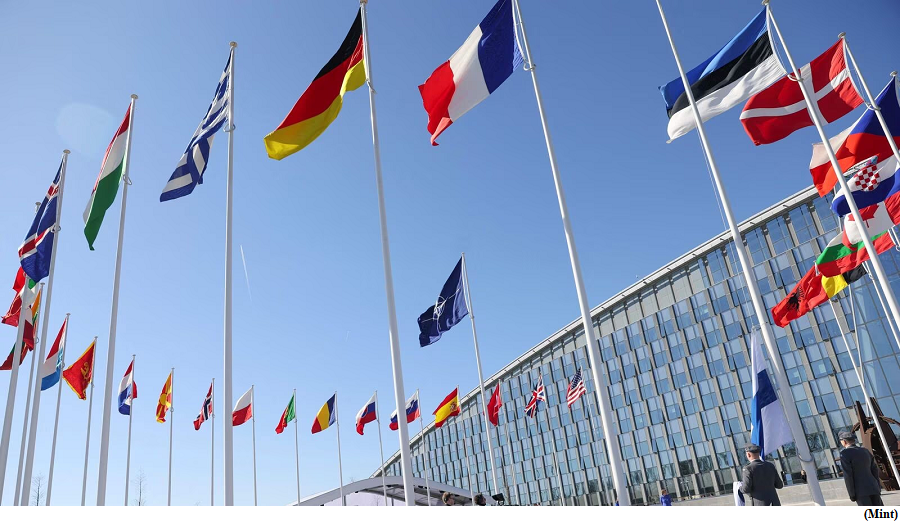On Finland’s journey to join NATO (GS Paper 2, International Organisation)

Why in news?
- Recently, Finland finally became the 31st country to join the North Atlantic Treaty Organization (NATO).
- The move to join the security alliance was precipitated by the Russian invasion of Ukraine in 2022.
What has been Russia’s response?
- The Russian Foreign Ministry said that while it will respond with “military-technical measures”, the specifics of its actions will depend on the terms under which Finland joins NATO.
- The Ministry deemed the now-defunct policy of non-alignment as a “wise decision” and said that Finland has now “lost its independence”.
- It made clear, in no ambiguous terms, that this decision “will have a negative effect on the bilateral relations between Russia and Finland”.
How has Finland’s security policy evolved via its neighbour?
- Before the First Soviet-Finnish War, Russia sought to establish a buffer zone along its western border as a means of protecting itself because of its history of being invaded by foreign powers through Finland.
- Lingering tensions from the Russian Revolution and the Finnish Civil War between 1917 and 1918 as well as unresolved issues from the Treaty of Dorpat in 1920 were responsible for the First Soviet-Finnish War.
- The Second Soviet-Finnish War, which took place between 1941 and 1944 ended with the defeat of Finland.
- Finland lost territories to the Soviet Union and had to pay war reparations. This, coupled with the independence process in 1917, the civil war between 1918 and 1919, and the Lapland War in 1944 impacted the collective psyche of the Finns.
- This made Finland pursue a pragmatic security policy which was flexible enough to balance its autonomy with the need for military cooperation with the West. It was careful of not taking overt actions which could be seen as a security threat by Russia.
Paasikivi Line:
- Finland made concessions to the Soviet Union, one of which was the Finno-Soviet Treaty of 1948. This treaty ensured that Finland would remain neutral and would not allow any foreign troops on its soil without permission from Moscow.
- While this helped Finland boost trade with the Soviet Union, it became heavily dependent on Moscow thereby making it vulnerable to economic and political overtures from the Soviets.
- After the Second World War, Paasikivi’s line emerged and began to morph into what would eventually become Finland’s foreign policy strategy.
- Named after Juho Kusti Paasikivi, the President of Finland between 1946 and 1956, Paasikivi’s line was based on the idea of peaceful coexistence with the Soviet Union with neutrality being its cornerstone. It helped Finland navigate complex international relations after the turbulent time of the Second World War.
Why did the security policy change?
- Finland’s experience during the Cold War shaped its approach to security policy. Following the collapse of the Soviet Union in 1991, it sought to build closer ties with Russia while also pursuing greater integration with Europe.
- The country has been an active participant in European security initiatives such as the Common Security and Defence Policy (CSDP) and the Nordic Defence Cooperation (NORDEFCO). At the same time, it has been able to maintain close economic ties with Russia.
- However, there were tensions between Finland and Russia as a result of the flux in domestic politics in both countries.
- For instance, Nikita Khrushchev was willing to negotiate with Finland and allowed for increased trade and cultural exchange between the two countries, despite the 1950s seeing Finland side with the West when the Soviet Union called for a boycott of the 1956 Summer Olympics in Australia.
Could there have been an alternative to joining NATO?
- For Finland, an alternative to joining NATO could have been to develop its own military capabilities and pursue a deeper level of cooperation with other European countries, through arrangements like the CSDP and the NORDEFCO.
- However, the annexation of Crimea by Russia in 2014, Russia’s invasion of Ukraine in 2022, and a declining Russian influence made the decision for the risk-averse Finns easy.
What lies ahead?
- The continuation of the Ukraine invasion, a declining Russian might, and now a confirmed security umbrella by NATO gives the impression that Finland’s security concerns are mostly assuaged.
- The extent to which this new cooperation between the Finns and the NATO countries pan out will dictate Russia’s actions, but it seems that Moscow, under the leadership of President Vladimir Putin, might wish to further escalate by increasing troop presence along the Russo-Finnish border.
About NATO:
- North Atlantic Treaty Organization (NATO) is a military alliance established by the North Atlantic Treaty (also called the Washington Treaty) of April, 1949, by the United States, Canada, and several Western European nations to provide collective security against the Soviet Union.
- There are currently 31 member states.
- Its original members were Belgium, Canada, Denmark, France, Iceland, Italy, Luxembourg, the Netherlands, Norway, Portugal, the United Kingdom, and the United States.
- Joining the original signatories were Greece and Turkey (1952), West Germany (1955, from 1990 as Germany), Spain (1982), the Czech Republic, Hungary, and Poland (1999), Bulgaria, Estonia, Latvia, Lithuania, Romania, Slovakia, and Slovenia (2004), Albania and Croatia (2009), Montenegro (2017), North Macedonia (2020) and Finland (2023).
- France withdrew from the integrated military command of NATO in 1966 but remained a member of the organization, it resumed its position in NATO’s military command in 2009.


